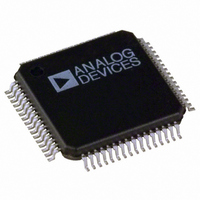ADV7180BSTZ Analog Devices Inc, ADV7180BSTZ Datasheet - Page 52

ADV7180BSTZ
Manufacturer Part Number
ADV7180BSTZ
Description
IC VIDEO DECODER SDTV 64-LQFP
Manufacturer
Analog Devices Inc
Type
Video Decoderr
Datasheet
1.ADV7180BSTZ.pdf
(116 pages)
Specifications of ADV7180BSTZ
Design Resources
Low Cost Differential Video Receiver Using ADA4851 Amplifier and ADV7180 Video Decoder (CN0060) Low Cost Video Multiplexer for Video Switching Using ADA4853-2 Op Amp with Disable Function (CN0076)
Applications
Digital Cameras, Mobile Phones, Portable Video
Voltage - Supply, Analog
1.71 V ~ 1.89 V
Voltage - Supply, Digital
1.65 V ~ 2 V
Mounting Type
Surface Mount
Package / Case
64-LQFP
Resolution (bits)
10bit
Input Format
Analog
Output Format
Digital
Adc Sample Rate
57.27MSPS
Power Dissipation Pd
15µW
No. Of Input Channels
6
Supply Voltage Range
1.71V To 1.89V
Lead Free Status / RoHS Status
Lead free / RoHS Compliant
For Use With
EVAL-ADV7180LQEBZ - BOARD EVALUATION ADV7180EVAL-ADV7180LFEBZ - BOARD EVAL FOR ADV7180 LFCSP
Lead Free Status / RoHS Status
Lead free / RoHS Compliant, Lead free / RoHS Compliant
Available stocks
Company
Part Number
Manufacturer
Quantity
Price
Company:
Part Number:
ADV7180BSTZ
Manufacturer:
AMIS
Quantity:
6 240
Company:
Part Number:
ADV7180BSTZ
Manufacturer:
Analog Devices Inc
Quantity:
10 000
Part Number:
ADV7180BSTZ
Manufacturer:
ADI/亚德诺
Quantity:
20 000
Company:
Part Number:
ADV7180BSTZ-REEL
Manufacturer:
Analog Devices Inc
Quantity:
10 000
ADV7180
SYNC PROCESSING
The ADV7180 has two additional sync processing blocks that
postprocess the raw synchronization information extracted
from the digitized input video. If desired, the blocks can be
disabled via the following two I
ENVSPROC.
ENHSPLL, Enable HSYNC Processor, Address 0x01[6]
The HSYNC processor is designed to filter incoming HSYNCs that
have been corrupted by noise, providing improved performance
for video signals with stable time bases but poor SNR.
Setting ENHSPLL to 0 disables the HSYNC processor.
Setting ENHSPLL to 1 (default) enables the HSYNC processor.
ENVSPROC, Enable VSYNC Processor, Address 0x01[3]
This block provides extra filtering of the detected VSYNCs to
improve vertical lock.
Setting ENVSPROC to 0 disables the VSYNC processor.
Setting ENVSPROC to 1 (default) enables the VSYNC processor.
VBI DATA DECODE
The following are the two VBI data slicers on the ADV7180: the
VBI data processor (VDP) and the VBI System 2.
The VDP can slice both low bandwidth standards and high
bandwidth standards such as teletext. VBI System 2 can slice
low data rate VBI standards only.
The VDP is capable of slicing multiple VBI data standards on
SD video. It decodes the VBI data on the incoming CVBS and
Y/C or YUV data. The decoded results are available as ancillary
data in output 656 data stream. For low data rate VBI standards
like CC/WSS/CGMS, users can read the decoded data bytes
from the I
The VBI data standards that can be decoded by the VDP are
listed in Table 67 and Table 68.
Table 67. PAL
Feature
Teletext System A, C, or D
Teletext System B/WST
Video Programming System (VPS)
Vertical Interval Time Codes (VITC)
Wide Screen Signaling (WSS)
Closed Captioning (CCAP)
2
C registers.
2
C bits: ENHSPLL and
Not applicable
Standard
ITU-R BT.653
ITU-R BT.653
ETSI EN 300 231 V 1.3.1
ITU-R BT.1119-1/
ETSI EN.300294
Not applicable
Rev. F | Page 52 of 116
Table 68. NTSC
Feature
Teletext System B and D
Teletext System C/NABTS
Vertical Interval Time Codes (VITC)
Copy Generation Management
Gemstar
Closed Captioning (CCAP)
The VBI data standard that the VDP decodes on a particular
line of incoming video has been set by default as described in
Table 69. This can be overridden manually and any VBI data can
be decoded on any line. The details of manual programming are
described in Table 70.
VDP Default Configuration
The VDP can decode different VBI data standards on a line-to-
line basis. The various standards supported by default on different
lines of VBI are explained in Table 69.
VDP Manual Configuration
MAN_LINE_PGM, Enable Manual Line Programming of
VBI Standards, Address 0x64[7], User Sub Map
The user can configure the VDP to decode different standards on
a line-to-line basis through manual line programming. For this,
the user must set the MAN_LINE_PGM bit. The user must write
into all the line programming registers, VBI_DATA_Px_Ny and
VBI_DATA_Px (see Register 0x64 to Register 0x77 in Table 108).
When MAN_LINE_PGM to 0 (default) is set, the VDP decodes
default standards on lines, as shown in Table 69.
When MAN_LINE_PGM to 1 is set, the VBI standards to be
decoded are manually programmed.
VBI_DATA_Px_Ny[3:0], VBI_DATA_Px[3:0], VBI
Standard to be Decoded on Line X for PAL, Line Y for
NTSC, Address 0x64 to Address 0x77, User Sub Map
These are related 4-bit clusters in Register 0x64 to Register 0x77
of the user sub map. These 4-bit, line programming registers,
VBI_DATA_Px_Ny and VBI_DATA_Px, identify the VBI data
standard that are decoded on Line X in PAL mode or on Line Y
in NTSC mode. The different types of VBI standards decoded
by VBI_DATA_Px_Ny and VBI_DATA_Px are shown in
Table 70. Note that the X or Y value depends on whether the
ADV7180 is in PAL or NTSC mode.
System (CGMS)
Standard
ITU-R BT.653
ITU-R BT.653/EIA-516
Not applicable
EIA-J CPR-1204/IEC 61880
Not applicable
EIA-608













